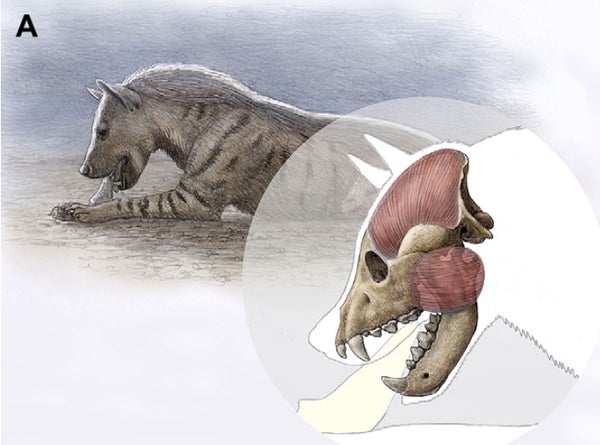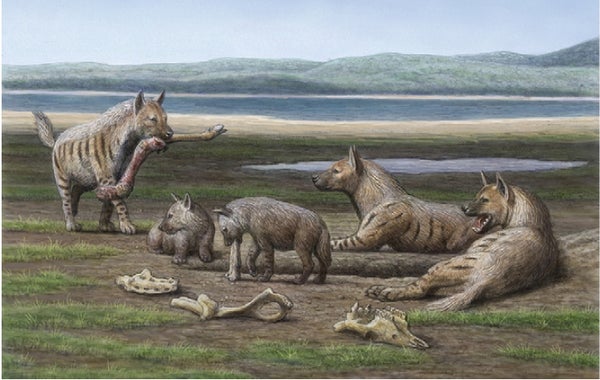This article was published in Scientific American’s former blog network and reflects the views of the author, not necessarily those of Scientific American
On supporting science journalism
If you're enjoying this article, consider supporting our award-winning journalism by subscribing. By purchasing a subscription you are helping to ensure the future of impactful stories about the discoveries and ideas shaping our world today.
Hyenas have watched our entire history. It was easy given that they had a few million years' head start on us. The earliest of their kind evolved from civet-like ancestors over 15 million years ago, while our earliest human ancestors didn’t break away from other apes until about 6 million years ago. Hyenas were loping around long before humans tried to hit the ground running. And of all the hyenas that ever lived, there’s one species whose paw had quite an influence shaping our past. It was the largest bone-crusher ever known, Pachycrocuta brevirostris.
Follow our ancestor’s fossil trail and you’ll run into the lion-sized hyena at various spots through the Old World. About 1.3 million years ago, in southeastern Spain, humans and Pachycrocutajockeyed for possession of a delectable elephant carcass. The humans of China’s Dragon Bone Hill didn’t fare quite so well. Most of the Homo erectus scraped up from the 750,000 – 400,000 year old cave sediments show how the local Pachycroctua busted up their bodies. But whether as rivals or prey, our fate was tied to theirs for an immense span of time. For hundreds of thousands of years after humans left Africa, paleontologist Joan Madurell-Malapeira and colleagues concluded in a recent paper, our forebears competed with Pachycrocuta for rights to meaty megafaunal carcasses.
Prehistoric people didn’t set out to pick fights with giant hyenas. At least, such a foolhardy scheme has never shown up in the fossil record. (Then again, maybe there wouldn't be any bones left.) It was more of a matter that we were all after the same thing. Even an adult elephant carcass can be completely stripped of flesh within the space of two weeks. If you want meat, you have to move fast. Hyenas evolved to handle such a task, and, through our Stone Age culture, we were trying to imitate them. We held our own, but evolution had naturally given Pachycrocuta an edge.
Paleontologist Paul Palmqvist and colleagues outlined the destructive capabilities of Pachycrocuta in a 2011 study that looked at both the table scraps and biomechanics of the beast. Pachycrocuta was not a hyena quite like the ones we known today. Adult Pachycrocuta brevirostris had skulls about as large as those of an adult male lions, yet their shoulder height was not much above that of today’s spotted hyenas. Pachycrocuta was stockier, in other words, slung lower to the ground despite being 20% larger than its modern, cackling cousins. Pachycrocuta was not a speedy hyena that chased down prey, but had the build of a habitual scavenger adapted to hauling off large chunks of carcasses back to the den.
One such hyena home, found in the 1.5 million year old strata of Guadix-Baza basin, Spain, acted as the focal point for the study by Palmqvist and coauthors. Over 5,800 bones belonging to 21 taxa of large animals have been excavated here, but these bones were not washed in or accumulated by the elements. Pachycrocuta brought them there, leaving their mark on busted and gnawed bones. In particular, the giant hyenas frequently broke open the humeri and tibiae of the deer, bovid, and horse carcasses they brought back, probably because these were both easier to crack and had more delicious fatty marrow inside. The pattern resembles what’s seen in the dens of striped hyenas, who get much of their meat from scavenging.

Pachycrocuta gnawing on a bone. Credit: Mauricio Anton Palmqvist et al. 2011
But how much of the Pachycrocuta diet was carrion? Hyenas are still dogged by a reputation as filthy scavengers, even though the smallest – the aardwolf – is an insect specialist and spotted hyenas are dedicated hunters who are often robbed by lions. Only the striped and brown hyenas could truly labeled as scavengers, and, even then, they supplement their diet with small prey and fruit. What, then, to make of a burly, lion-sized hyena with powerful jaws? Did Pachycrocuta rely on luck and stealing what it could from kills made by sabercats and other carnivores?
In answer, Pachycrocuta offers a paradox. Striped and brown hyenas often scavenge, Palmqvist and colleagues note, but they are more lightly built than spotted hyenas. That’s because seeking out rotted meat ready to eat requires traversing great distances and a significant time investment. Being heavy isn’t an advantage when you’re often on the move. Not to mention that big carnivores today are primarily hunters who supplement their diets with carrion rather than the other way around. Pachycrocuta looks like a hyena easily able to reduce a carcass to splinters, yet is almost too big for the job.
But Pachycrocuta didn’t live in our world. This hyena prowled during a time when there was a much more diverse guild of carnivores, Palmqvist and coauthors wrote, including sabertoothed cats who have often been interpreted as leaving meaty, messy kills. Maybe Pachycrocuta was a very dedicated kleptoparasite, watching for carrion birds or following the cats to steal what the felines took down. This might explain why the Guadix-Baza den represents a wide array of herbivores rather than the narrowed range of menu options expected of a predator suited to certain habitats or prey types. Maybe Pachycrocuta took whatever it could get.
To the consternation paleontologists, early humans did not immortalize Pachycrocuta in art for us to know how this giant really behaved. The beast died out before we got around to inventing symbolism. We were more concerned with meat. Whether the huge hyenas hunted alone or in packs, relied on robbing other kills or hunted their own protein, or were striped, spotted, or wore a different pattern altogether are all questions that currently have no answers. But I can’t help but wonder how they shaped our past. You can’t live in the shadow of such an impressive carnivore for over a million years and remain unchanged.
References:
Madurell-Malapeira, J., Alba, D., Espigares, M., Vinuesa, V., Palmqvist, P., Martínez-Navarro, B., Moyà-Solà, S. 2015. Were large carnivorans and great climatic shifts limiting factors for hominin dispersals? Evidence of the activity of Pachycrocuta brevirostris during the Mid-Pleistocene Revolution in the Vallparadís Section (Vallès-Penedès Basin, Iberian Peninsula). Quaternary International. doi: 10.1016/j.quaint.2015.07.040
Palmqvist, P., Martínez-Navarro, B., Pérez-Claros, J., Torregrosa, V., Figueirido, B., Jiménez-Arenas, J., Espigares, M., Ros-Montoya, S., De Renzi, M. 2011. The giant hyena Pachycrocuta brevirostris: Modelling the bone-cracking behavior of an extinct carnivore. Quaternary International. doi: 10.1016/j.quaint.2010.12.035
